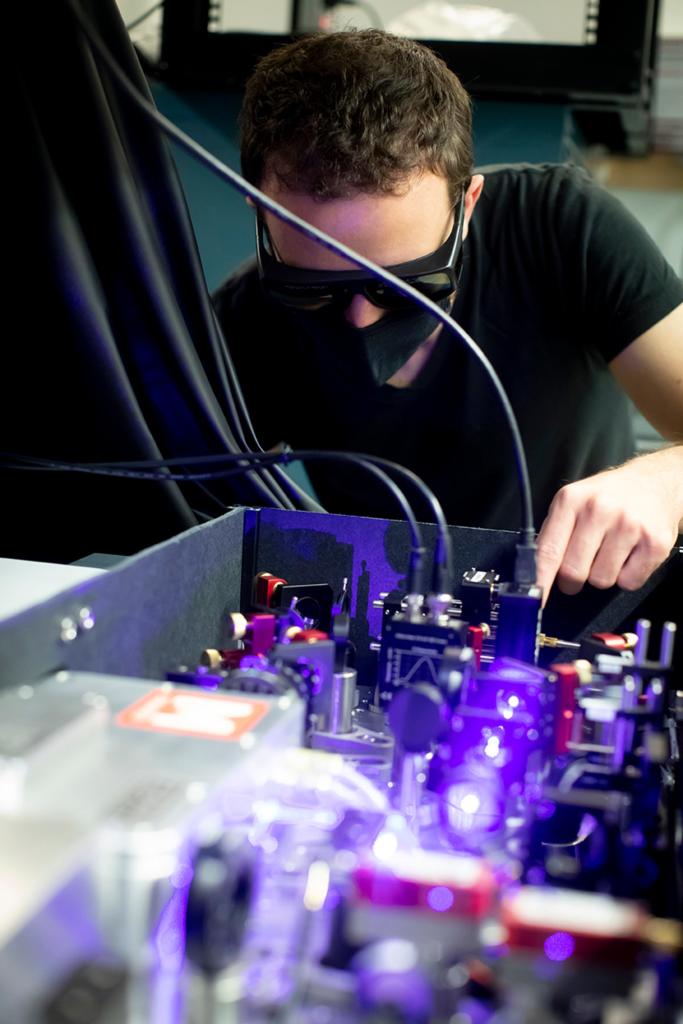Above – By arranging them in sequential frames and taking images of single atoms, the researchers can even make fun atom videos. Courtesy of Lukin group
According to Sepehr Ebadi, a physics student in the Graduate School of Arts and Sciences and the study’s lead author, it is the combination of system’s unprecedented size and programmability that puts it at the cutting edge of the race for a quantum computer, which harnesses the mysterious properties of matter at extremely small scales to greatly advance processing power. Under the right circumstances, the increase in qubits means the system can store and process exponentially more information than the classical bits on which standard computers run.
“The number of quantum states that are possible with only 256 qubits exceeds the number of atoms in the solar system,” Ebadi said, explaining the system’s vast size.
Already, the simulator has allowed researchers to observe several exotic quantum states of matter that had never before been realized experimentally, and to perform a quantum phase transition study so precise that it serves as the textbook example of how magnetism works at the quantum level.

These experiments provide powerful insights on the quantum physics underlying material properties and can help show scientists how to design new materials with exotic properties.
The project uses a significantly upgraded version of a platform the researchers developed in 2017, which was capable of reaching a size of 51 qubits. That older system allowed the researchers to capture ultra-cold rubidium atoms and arrange them in a specific order using a one-dimensional array of individually focused laser beams called optical tweezers.
This new system allows the atoms to be assembled in two-dimensional arrays of optical tweezers. This increases the achievable system size from 51 to 256 qubits. Using the tweezers, researchers can arrange the atoms in defect-free patterns and create programmable shapes like square, honeycomb, or triangular lattices to engineer different interactions between the qubits.
“The workhorse of this new platform is a device called the spatial light modulator, which is used to shape an optical wavefront to produce hundreds of individually focused optical tweezer beams,” said Ebadi. “These devices are essentially the same as what is used inside a computer projector to display images on a screen, but we have adapted them to be a critical component of our quantum simulator.
SOURCES- Harvard

Brian Wang is a Futurist Thought Leader and a popular Science blogger with 1 million readers per month. His blog Nextbigfuture.com is ranked #1 Science News Blog. It covers many disruptive technology and trends including Space, Robotics, Artificial Intelligence, Medicine, Anti-aging Biotechnology, and Nanotechnology.
Known for identifying cutting edge technologies, he is currently a Co-Founder of a startup and fundraiser for high potential early-stage companies. He is the Head of Research for Allocations for deep technology investments and an Angel Investor at Space Angels.
A frequent speaker at corporations, he has been a TEDx speaker, a Singularity University speaker and guest at numerous interviews for radio and podcasts. He is open to public speaking and advising engagements.


Could one build a quantum communication device to test the Many Worlds theory?
An experiment along the lines of a 4-qubit box in an experiment where you are randomly assigned the starting role of Writer or Reader, communicating Pi's digits.
(To 'align' with Another World, the box might have Pi written on it to maybe 20 decimal places, as well as the date and time the experiment is to start, and it will be destroyed after one use. This is to maybe avoid connecting with worlds doing a different experiment, or the same experiment out of synch.)
If Writer, you've got 60 seconds to enter the first digit of Pi (as a binary-coded decimal value), which is entered into the 4 qubits, then wait 60 seconds for a hypothetical Other World Reader to read it. (You could do Pi in binary with a single qubit, but that'd be really slow, and not as impressive!)
If Reader, you wait 60 seconds and then observe the qubit result over the following 60 seconds – which should be the first digit of Pi, if Many Worlds is correct.
At some point in the next 60 seconds, BOTH roles press a button to re-entangle the qubits, and swap roles to Reader or Writer for the next two 60 second periods – to read the next digit of Pi or enter it. Etc.
If it doesn't work, it doesn't disprove Many Worlds, but if it works, it seems like it'd be pretty definitively proven?
(My experiment design above might not be correct, but you get the idea at least?)
Apparently God likes Mario bros too
I want Pitfall Harry
256 qubits, but how are they entangled ? 256 entangled qubits would be huge, but 256 qubits entangled 4 by 4, much less so…
Waka Waka Waka Waka…